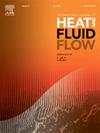Effects of cooling hole blockage on heat transfer and film cooling effectiveness of gas turbine squealer tip
IF 2.6
3区 工程技术
Q2 ENGINEERING, MECHANICAL
International Journal of Heat and Fluid Flow
Pub Date : 2024-12-07
DOI:10.1016/j.ijheatfluidflow.2024.109678
引用次数: 0
Abstract
The complex flow fields in the squealer tip region are conducive to the particle deposition and cooling hole blockage of gas turbine blades. The blockage of film cooling hole causes the elevation of heat load and reduction of film cooling effect in the squealer tip gap. In this paper, influences of cooling hole blockage on the film cooling effectiveness and heat transfer on the squealer tip are investigated by means of numerical methods. To describe the degree of hole blockage, the blockage ratio B and the blockage angle β are introduced for the film cooled squealer tip with cooling hole blockage. The film cooling effectiveness and heat transfer coefficient on the squealer tip are obtained at the three blowing ratios (M = 0.5, 1.0, and 2.0), three blockage ratios (B = 0.2, 0.4, and 0.8), and three blockage angles (β = 20°, 30°, and 40°). The results show that the film cooling effectiveness and heat transfer on the squealer tip is highly dependent on the blockage ratio, but not sensitive to the variation of blockage angle. The cooling hole blockage has a profound effect on the coolant ejection velocity and angle. At M = 0.5 and 1.0, the film cooling effectiveness is reduced by 32.11 % and 39.40 % respectively for the blocked case with B = 0.6 and β = 40° compared to the design case (i.e. no blockage), whereas the averaged heat transfer coefficient on the cavity floor for the blocked case with B = 0.6 and β = 20° is increased by 9.77 % and 12.57 % respectively compared to the design case. The effect of cooling hole blockage on the heat transfer coefficient of the squealer tip exhibits irregular characteristic at M = 2.0. The highest heat load is observed on the squealer tip at B = 0.4 and β = 40°, and the lowest film cooling effectiveness is observed at B = 0.4, β = 30°. In these cases, the averaged film cooling effectiveness is decreased by 25.49 % compared to the design cases, and the averaged heat transfer coefficient on the cavity floor is increased by 14.6 %.
求助全文
约1分钟内获得全文
求助全文
来源期刊

International Journal of Heat and Fluid Flow
工程技术-工程:机械
CiteScore
5.00
自引率
7.70%
发文量
131
审稿时长
33 days
期刊介绍:
The International Journal of Heat and Fluid Flow welcomes high-quality original contributions on experimental, computational, and physical aspects of convective heat transfer and fluid dynamics relevant to engineering or the environment, including multiphase and microscale flows.
Papers reporting the application of these disciplines to design and development, with emphasis on new technological fields, are also welcomed. Some of these new fields include microscale electronic and mechanical systems; medical and biological systems; and thermal and flow control in both the internal and external environment.
 求助内容:
求助内容: 应助结果提醒方式:
应助结果提醒方式:


